15. Regression and regularisation#
Regression is used when prediction a continuous dependent variable using one ore more independent variables.
Most well known classical regression model is Ordinary Least Mean Squares (OLS) regression
Classical regression is not working well when the number of features is large or when the data contains plenty of noise or the dependency is non-linear
Application areas of classical regression can be extended by using regularisation
Non-linear regression models are better when the dependency is not linear
Many new regression models can also tolerate high dimensionality and non gaussian noise better than classical methods
Some often used regression methods, also suited for non-linear dependencies and high-dimensional data are Suppor Vector Regression (SVR), Random Forest Regression (RFR), and Gradient Boosted Regression Trees (GBRT). See the discussion of usage of corresponding Support Vector Machine (SVM), Random Forest, and Gradient Boosting for classification, since their operating principles are the same for regression and classification.
Recursive feature elimination/addition are useful methods for model optimisation and feature selection
15.1. Ordinary Least mean Squares (OLS) regression#
OLS using p-features \(x_i\) to predict variable \(y\).
\(x_i\) are called as independent variables
\(y\) is called as a dependent variable
\(\beta_i\) are the model parameters
\(\beta_0\) is the intersection, which is not always modeled
Cost function to be minimized (square error):
This Classic regression, usually the first choice to be tested. It Does not work well when p is large and when the training data contains plenty of noise
The prediction with the model is the following:
In 1-dimensional case, the regression is simply
where \(\beta_1\) is the reciprocal and \(\beta_0\) is the constant (the y-axis crossing point) and \(\epsilon\) is the prediction error. The optimal solution is when the squared sum of error (Loss function, \(L()\)) between predicted and true values is minimized:
The linear regression has a well known solution, which can be calculated very efficiently (closed form):
Where \(\mathbf{X}\) is a design matrix containing data samples in rows, and variables in columns. It is also called as design matrix, at it was shown in the top of this section.
15.2. The fitness of a regression model#
The fitness of a regression model is often estimated using coefficient of determination (\(R^2\)) or Root Mean Square Error of prediction (RMSE).
15.2.1. Coefficient of determination, \(R^2\)#
The coefficient of determination, \(R^2\), defines how large proportion of the variance in \(y\) is explained by the model. \(R^2\) is zero if the model cannot predict anything and it is 1 when the model fit is perfect.
For Ordinary Least mean Squares regression models (OLS) it is the same as the square of the Pearson correlation coefficient.
15.2.2. Root Mean Square Error, RMSE#
RMSE, is another often used measure for model fitness. RMSE shows the average prediction error in the same units and scale than \(y\).
15.3. Regularization and model simplicication#

Ockham - from a manuscipt of Ockham’s Summa Logicae, MS Gonville and Caius College, Cambridge, 464/571, fol. 69r
“Simpler solutions are more likely to be correct than complex ones”
William of Ockham
Finding a model which fits to the data is not necessarily optimal. It may be unnecessary complex, which can cause problems in:
Generalization: too complex models may have unnecessary complex decision boundary or use redundant or unimportant variables in a regression model, which are producing noise to the model. The model may event fit to the noise in the training data, which is not repeated similarly in new samples.
Explainability: A complex model is difficult to understand, explain and believe.
Stability: Too complex model may have problems in converging in noisy training data and also the prediction can be too noise sensitive
Unnecessary high dimensionality means costs in recording, transferring, storing and processing data
Therefore it is important to use means for simplifying data and making the models more stable.
15.3.1. L2 regularization, Ridge regression#
Regularization term, \(\Omega(\Theta)\), makes it suitable for higher dimensional data
Minimal unbiased estimator in certain cases
Can be solved in closed form
All coefficients are always kept -> Does not provide a parsimonious model
15.3.2. L1 regularization, LASSO#
L1 regularization tends to lead solutions where many coefficients, \(\beta_i\) will be zeros -> sparse model.
Only iterative solutions are available, but for example Least Angle Regression (LARS) is fast method for finding LASSO solution
Will saturate if p>n, and select at maximum n feautures
in cases where n>p and high correlation between predictors, L1 is worse than L2
15.3.3. Elastic nets#
Elastic net can perform like Rigde regression, when \(\alpha\)=0 or like LASSO when \(\alpha\)=1
For suitable value of, \(\alpha\), elastic net will also produce sparse model, but it does not saturate to in cases when n<p like LASSO.
Can tolerate correlation between predictors
Can be computed interatively quite efficiently
15.3.4. Gradient Tree Boosting#
Also called as Gradient Boosted Regression Trees (GBRT)
The GBRT has similar formal loss function and measure for complexity as linear regrssion
15.4. Coding examples#
Pay attention especially for these rows
Build the model:
model = Model(<model parameters>).fit(X,y)
Validate the model with R2 score in testing set and calculating Cross validation R2 score or R2 score and finaly for a separate testing set:
model.score(X,y) model.cross_val_score(model, X, y, cv=5).mean() model.score(X_test, y_test)
Variable selection:
sfm = SelectFromModel(model, threshold=0.3) cross_val_score(model, sfm.transform(X), y, cv=5).mean() model.score(sfm.transform(X),y)
Recursive feature selection
rfe = RFE(estimator=model, n_features_to_select=1, step=1)
15.4.1. Boston house prizes example#
Can the house prizes be predicted? Which parameters affect most to the house prizes?
- CRIM per capita crime rate by town
- ZN proportion of residential land zoned for lots over 25,000 sq.ft.
- INDUS proportion of non-retail business acres per town
- CHAS Charles River dummy variable (= 1 if tract bounds river; 0 otherwise)
- NOX nitric oxides concentration (parts per 10 million)
- RM average number of rooms per dwelling
- AGE proportion of owner-occupied units built prior to 1940
- DIS weighted distances to five Boston employment centres
- RAD index of accessibility to radial highways
- TAX full-value property-tax rate per \$10,000
- PTRATIO pupil-teacher ratio by town
- B 1000(Bk - 0.63)^2 where Bk is the proportion of blacks by town
- LSTAT % lower status of the population
- MEDV Median value of owner-occupied homes in $1000's
import numpy as np
from sklearn.datasets import load_boston
from sklearn.linear_model import LinearRegression, Ridge, Lasso, ElasticNet, LassoCV, ElasticNetCV
from sklearn.feature_selection import SelectFromModel
import seaborn as sns
from sklearn.model_selection import cross_val_score
import pandas as pd
from sklearn.preprocessing import StandardScaler
scaler = StandardScaler()
boston=load_boston()
# Scaling is not necessary, but can be done
X= scaler.fit_transform(boston['data'])
Xorig= boston['data']
y= boston['target']
Boston = pd.DataFrame(data=X, columns=boston['feature_names'])
Boston['target'] = y
print(Boston.shape)
Boston.head()
(506, 14)
/home/petri/venv/python3/lib/python3.9/site-packages/sklearn/utils/deprecation.py:87: FutureWarning: Function load_boston is deprecated; `load_boston` is deprecated in 1.0 and will be removed in 1.2.
The Boston housing prices dataset has an ethical problem. You can refer to
the documentation of this function for further details.
The scikit-learn maintainers therefore strongly discourage the use of this
dataset unless the purpose of the code is to study and educate about
ethical issues in data science and machine learning.
In this special case, you can fetch the dataset from the original
source::
import pandas as pd
import numpy as np
data_url = "http://lib.stat.cmu.edu/datasets/boston"
raw_df = pd.read_csv(data_url, sep="\s+", skiprows=22, header=None)
data = np.hstack([raw_df.values[::2, :], raw_df.values[1::2, :2]])
target = raw_df.values[1::2, 2]
Alternative datasets include the California housing dataset (i.e.
:func:`~sklearn.datasets.fetch_california_housing`) and the Ames housing
dataset. You can load the datasets as follows::
from sklearn.datasets import fetch_california_housing
housing = fetch_california_housing()
for the California housing dataset and::
from sklearn.datasets import fetch_openml
housing = fetch_openml(name="house_prices", as_frame=True)
for the Ames housing dataset.
warnings.warn(msg, category=FutureWarning)
| CRIM | ZN | INDUS | CHAS | NOX | RM | AGE | DIS | RAD | TAX | PTRATIO | B | LSTAT | target | |
|---|---|---|---|---|---|---|---|---|---|---|---|---|---|---|
| 0 | -0.419782 | 0.284830 | -1.287909 | -0.272599 | -0.144217 | 0.413672 | -0.120013 | 0.140214 | -0.982843 | -0.666608 | -1.459000 | 0.441052 | -1.075562 | 24.0 |
| 1 | -0.417339 | -0.487722 | -0.593381 | -0.272599 | -0.740262 | 0.194274 | 0.367166 | 0.557160 | -0.867883 | -0.987329 | -0.303094 | 0.441052 | -0.492439 | 21.6 |
| 2 | -0.417342 | -0.487722 | -0.593381 | -0.272599 | -0.740262 | 1.282714 | -0.265812 | 0.557160 | -0.867883 | -0.987329 | -0.303094 | 0.396427 | -1.208727 | 34.7 |
| 3 | -0.416750 | -0.487722 | -1.306878 | -0.272599 | -0.835284 | 1.016303 | -0.809889 | 1.077737 | -0.752922 | -1.106115 | 0.113032 | 0.416163 | -1.361517 | 33.4 |
| 4 | -0.412482 | -0.487722 | -1.306878 | -0.272599 | -0.835284 | 1.228577 | -0.511180 | 1.077737 | -0.752922 | -1.106115 | 0.113032 | 0.441052 | -1.026501 | 36.2 |
# Ordinary Linear Regression First
lr=LinearRegression().fit(X,y)
yhat=lr.predict(X)
# Cross_val_score and score are coefficient of determinations, R^2
RsquaredCV=cross_val_score(lr, X, y, cv=5).mean()
RsquaredTR=lr.score(X,y)
sns.regplot(x=y,y=yhat, line_kws={"color": "red"})
plt.xlabel('True price')
plt.ylabel('Predicted price')
plt.title('Comparison of two-feature model, $R^2$=%3.2f' % RsquaredCV)
print("CV score..........", RsquaredCV)
print("Training score....", RsquaredTR)
CV score.......... 0.3532759243958824
Training score.... 0.7406426641094095
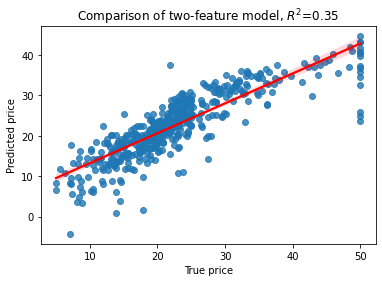
# Then L2 regularized Ridge Regression
rr=Ridge(alpha=12).fit(X,y)
yhat=rr.predict(X)
RsquaredCV=cross_val_score(rr, X, y, cv=5).mean()
RsquaredTR=rr.score(X,y)
sns.regplot(x=y,y=yhat, line_kws={"color": "red"})
plt.xlabel('True price')
plt.ylabel('Predicted price')
plt.title('Comparison of two-feature model, $R^2$=%3.2f' % RsquaredCV)
print("CV score..........", RsquaredCV)
print("Training score....", RsquaredTR)
CV score.......... 0.41282930221133507
Training score.... 0.7394797644213642
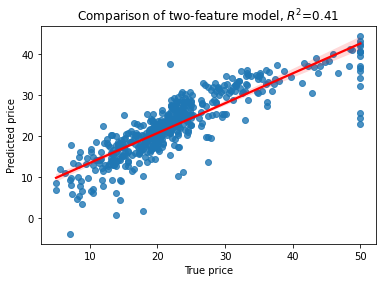
# L1 regularized Lasso Regerssion
la=Lasso(alpha=0.1).fit(X,y)
yhat=la.predict(X)
RsquaredCV=cross_val_score(la, X, y, cv=5).mean()
RsquaredTR=la.score(X,y)
sns.regplot(x=y, y=yhat, line_kws={"color": "red"})
plt.xlabel('True price')
plt.ylabel('Predicted price')
plt.title('Comparison of two-feature model, $R^2$=%3.2f' % RsquaredCV)
print("CV score..........", RsquaredCV)
print("Training score....", RsquaredTR)
CV score.......... 0.40368942076383674
Training score.... 0.7353093744353656
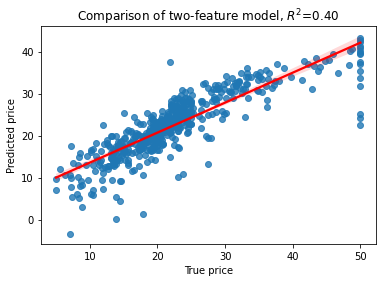
# L2 + L1 regularized Elastic Net
en=ElasticNet(alpha=0.5, l1_ratio=0.1).fit(X,y)
yhat=en.predict(X)
RsquaredCV=cross_val_score(en, X, y, cv=5).mean()
RsquaredTR=en.score(X,y)
sns.regplot(x=y, y=yhat, line_kws={"color": "red"})
plt.xlabel('True price')
plt.ylabel('Predicted price')
plt.title('Comparison of two-feature model, $R^2$=%3.2f' % RsquaredCV)
print("CV score..........", RsquaredCV)
print("Training score....", RsquaredTR)
CV score.......... 0.4497867885311699
Training score.... 0.6877704284092927
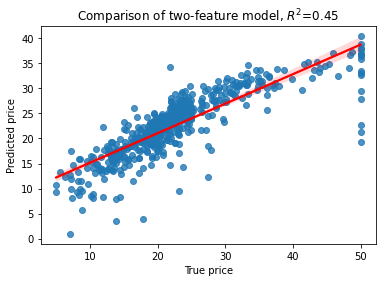
# Lets use Elastic Net for selecting the most relevant features
#model = LassoCV(cv=5)
model = ElasticNetCV(cv=5).fit(X,y)
yhat=model.predict(X)
RsquaredCV=cross_val_score(model, X, y, cv=5).mean()
RsquaredTR=en.score(X,y)
sns.regplot(x=y, y=yhat, line_kws={"color": "red"})
plt.xlabel('True price')
plt.ylabel('Predicted price')
plt.title('Comparison of two-feature model, $R^2$=%3.2f' % RsquaredCV)
print("CV score..........", RsquaredCV)
print("Training score....", RsquaredTR)
print("alpha=%f, L1-ratio=%f" % (model.alpha_, model.l1_ratio))
CV score.......... 0.4269743096160285
Training score.... 0.6877704284092927
alpha=0.192143, L1-ratio=0.500000
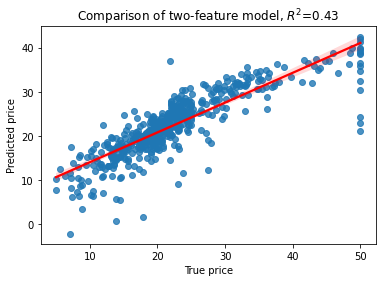
# Lets use Elastic Net for selecting the most relevant features
#model = LassoCV(cv=5)
model = ElasticNetCV(cv=5)
sfm = SelectFromModel(model, threshold=1.5)
sfm.fit(X, y)
print(sfm.transform(X).shape)
print("Selected variables are", sfm.transform([boston['feature_names'], boston['feature_names']])[0])
(506, 4)
Selected variables are ['RM' 'DIS' 'PTRATIO' 'LSTAT']
model.fit(sfm.transform(X), y)
yhat=model.predict(sfm.transform(X))
RsquaredCV=cross_val_score(model, sfm.transform(X), y, cv=5).mean()
RsquaredTR=model.score(sfm.transform(X),y)
sns.regplot(x=y,y=yhat, line_kws={"color": "red"})
plt.xlabel('True price')
plt.ylabel('Predicted price')
plt.title('Comparison of two-feature model, $R^2$=%3.2f' % RsquaredCV)
print("CV score..........", RsquaredCV)
print("Training score....", RsquaredTR)
Rsquared=sum((yhat-np.mean(y))**2)/sum((y-np.mean(y))**2)
CV score.......... 0.40003779874768786
Training score.... 0.6879971162429187
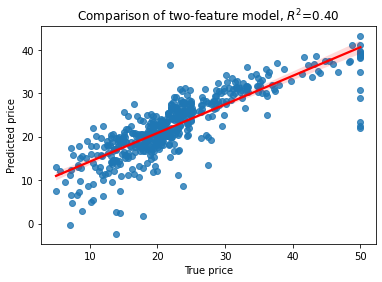
15.5. Gradient tree regression#
from sklearn.ensemble import GradientBoostingRegressor
from sklearn.model_selection import cross_val_score
#est = GradientBoostingRegressor(n_estimators=50, learning_rate=0.1,
# max_depth=2, random_state=0, loss='ls')
est = GradientBoostingRegressor(max_features=3)
est.fit(X, y)
yhat=est.predict(X)
RsquaredCV=cross_val_score(est, X, y, cv=5).mean()
RsquaredTR=est.score(X,y)
sns.regplot(x=y,y=yhat, line_kws={"color": "red"})
plt.xlabel('True price')
plt.ylabel('Predicted price')
plt.title('Comparison of two-feature model, $R^2$=%3.2f' % RsquaredCV)
print("CV score..........", RsquaredCV)
print("Training score....", RsquaredTR)
CV score.......... 0.6835129936048598
Training score.... 0.9681703971776361
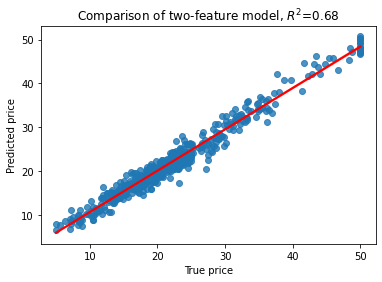
# Plot the importance of each feature
plt.figure(figsize=(12,5))
#Rsquared=sum((yhat-np.mean(y))**2)/sum((y-np.mean(y))**2)
i=range(len(boston.feature_names))
plt.stem(est.feature_importances_)
ax=plt.gca()
#ax.set_xticklabels(boston.feature_names);
for i in range(len(boston.feature_names)):
print("%2d %8s=%5.2f" % (i,boston.feature_names[i], est.feature_importances_[i]))
0 CRIM= 0.06
1 ZN= 0.01
2 INDUS= 0.09
3 CHAS= 0.01
4 NOX= 0.08
5 RM= 0.28
6 AGE= 0.02
7 DIS= 0.06
8 RAD= 0.00
9 TAX= 0.05
10 PTRATIO= 0.04
11 B= 0.01
12 LSTAT= 0.29
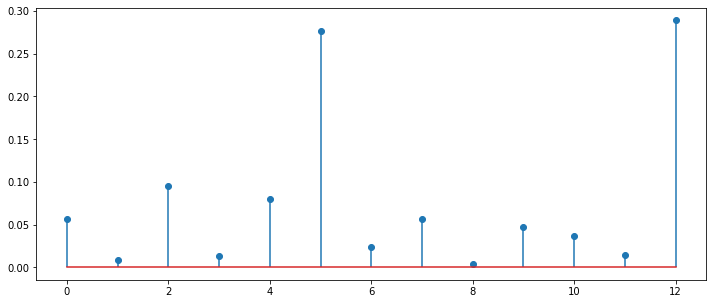
sns.heatmap( ))
Boston.corr()
| CRIM | ZN | INDUS | CHAS | NOX | RM | AGE | DIS | RAD | TAX | PTRATIO | B | LSTAT | target | |
|---|---|---|---|---|---|---|---|---|---|---|---|---|---|---|
| CRIM | 1.000000 | -0.200469 | 0.406583 | -0.055892 | 0.420972 | -0.219247 | 0.352734 | -0.379670 | 0.625505 | 0.582764 | 0.289946 | -0.385064 | 0.455621 | -0.388305 |
| ZN | -0.200469 | 1.000000 | -0.533828 | -0.042697 | -0.516604 | 0.311991 | -0.569537 | 0.664408 | -0.311948 | -0.314563 | -0.391679 | 0.175520 | -0.412995 | 0.360445 |
| INDUS | 0.406583 | -0.533828 | 1.000000 | 0.062938 | 0.763651 | -0.391676 | 0.644779 | -0.708027 | 0.595129 | 0.720760 | 0.383248 | -0.356977 | 0.603800 | -0.483725 |
| CHAS | -0.055892 | -0.042697 | 0.062938 | 1.000000 | 0.091203 | 0.091251 | 0.086518 | -0.099176 | -0.007368 | -0.035587 | -0.121515 | 0.048788 | -0.053929 | 0.175260 |
| NOX | 0.420972 | -0.516604 | 0.763651 | 0.091203 | 1.000000 | -0.302188 | 0.731470 | -0.769230 | 0.611441 | 0.668023 | 0.188933 | -0.380051 | 0.590879 | -0.427321 |
| RM | -0.219247 | 0.311991 | -0.391676 | 0.091251 | -0.302188 | 1.000000 | -0.240265 | 0.205246 | -0.209847 | -0.292048 | -0.355501 | 0.128069 | -0.613808 | 0.695360 |
| AGE | 0.352734 | -0.569537 | 0.644779 | 0.086518 | 0.731470 | -0.240265 | 1.000000 | -0.747881 | 0.456022 | 0.506456 | 0.261515 | -0.273534 | 0.602339 | -0.376955 |
| DIS | -0.379670 | 0.664408 | -0.708027 | -0.099176 | -0.769230 | 0.205246 | -0.747881 | 1.000000 | -0.494588 | -0.534432 | -0.232471 | 0.291512 | -0.496996 | 0.249929 |
| RAD | 0.625505 | -0.311948 | 0.595129 | -0.007368 | 0.611441 | -0.209847 | 0.456022 | -0.494588 | 1.000000 | 0.910228 | 0.464741 | -0.444413 | 0.488676 | -0.381626 |
| TAX | 0.582764 | -0.314563 | 0.720760 | -0.035587 | 0.668023 | -0.292048 | 0.506456 | -0.534432 | 0.910228 | 1.000000 | 0.460853 | -0.441808 | 0.543993 | -0.468536 |
| PTRATIO | 0.289946 | -0.391679 | 0.383248 | -0.121515 | 0.188933 | -0.355501 | 0.261515 | -0.232471 | 0.464741 | 0.460853 | 1.000000 | -0.177383 | 0.374044 | -0.507787 |
| B | -0.385064 | 0.175520 | -0.356977 | 0.048788 | -0.380051 | 0.128069 | -0.273534 | 0.291512 | -0.444413 | -0.441808 | -0.177383 | 1.000000 | -0.366087 | 0.333461 |
| LSTAT | 0.455621 | -0.412995 | 0.603800 | -0.053929 | 0.590879 | -0.613808 | 0.602339 | -0.496996 | 0.488676 | 0.543993 | 0.374044 | -0.366087 | 1.000000 | -0.737663 |
| target | -0.388305 | 0.360445 | -0.483725 | 0.175260 | -0.427321 | 0.695360 | -0.376955 | 0.249929 | -0.381626 | -0.468536 | -0.507787 | 0.333461 | -0.737663 | 1.000000 |
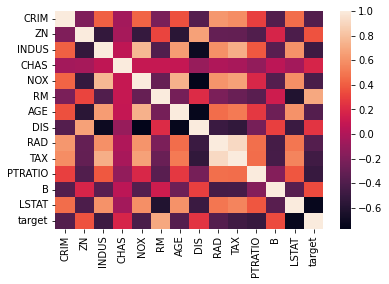
selected=est.feature_importances_.argsort()[-1:-4:-1]
print(selected)
Xs=X[:,selected]
print(Xs.shape)
ests = GradientBoostingRegressor()
ests.fit(Xs, y)
yhat=ests.predict(Xs)
RsquaredCV=cross_val_score(ests, Xs, y, cv=5).mean()
RsquaredTR=ests.score(Xs,y)
sns.regplot(x=y, y=yhat, line_kws={"color": "red"})
plt.xlabel('True price')
plt.ylabel('Predicted price')
plt.title('Comparison of two-feature model, $R^2$=%3.2f' % RsquaredCV)
print("CV score..........", RsquaredCV)
print("Training score....", RsquaredTR)
ests
[12 5 2]
(506, 3)
CV score.......... 0.5625462771221375
Training score.... 0.9304873266368128
GradientBoostingRegressor()
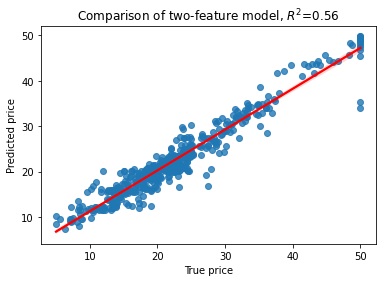
15.6. Recursive feature elimination#
An example of familiar digits classification
from sklearn.svm import SVC
from sklearn.datasets import load_digits
from sklearn.feature_selection import RFE
import matplotlib.pyplot as plt
# Load the digits dataset
digits = load_digits()
X = digits.images.reshape((len(digits.images), -1))
y = digits.target
# Create the RFE object and rank each pixel
svc = SVC(kernel="linear", C=1)
rfe = RFE(estimator=svc, n_features_to_select=1, step=1)
rfe.fit(X, y)
RFE(estimator=SVC(C=1, kernel='linear'), n_features_to_select=1)
ranking = rfe.ranking_.reshape(digits.images[0].shape)
# Plot pixel ranking
plt.matshow(ranking, cmap=plt.cm.Blues)
plt.colorbar()
plt.title("Ranking of pixels with RFE")
plt.show()
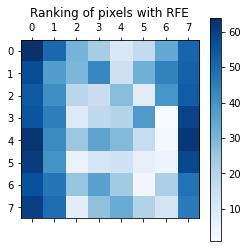
rfe.ranking_.reshape(digits.images[0].shape)
array([[64, 50, 31, 23, 10, 17, 34, 51],
[57, 37, 30, 43, 14, 32, 44, 52],
[54, 41, 19, 15, 28, 8, 39, 53],
[55, 45, 9, 18, 20, 38, 1, 59],
[63, 42, 25, 35, 29, 16, 2, 62],
[61, 40, 5, 11, 13, 6, 4, 58],
[56, 47, 26, 36, 24, 3, 22, 48],
[60, 49, 7, 27, 33, 21, 12, 46]])
15.7. Summary#
Classical regression is simple and well understood, and is a good model, when its conditions are met
The number of features is much less than number of samples
There is not too much noise in the data
The linear model is sufficient
Data needs to be normalized before use
Categorical data is not well supported, at least needs to be converted to numerical for example using one hot encoding
Regularisation includes many methods for balancing the trade off between model complexity and prediction error which prevents against over-fitting of the model
Regularization is often used in two forms: L2-regularization minimises the squared sum of model parameters, L1-regularization minimises the absolute sum of the model parameters.
Non-linear regression models SVR, RFR, GBRT extend the regression to non-linear problems
Ensemble models include a bag (parallel) or boosted (serial) combination of many simple models, which are randomized (bag) or boosted versions of simple regressors
Extratrees and Gradient Boosted Regression Trees can also use categorical data directly and they do not need the normalization of data
Recursive feature elimination (RFE)/addition are useful methods for model optimisation and feature selection
The feature importances measure in RF and GBTR models provides a clue for the importance of features
R2-score and RMSE are typical measures for model performance

